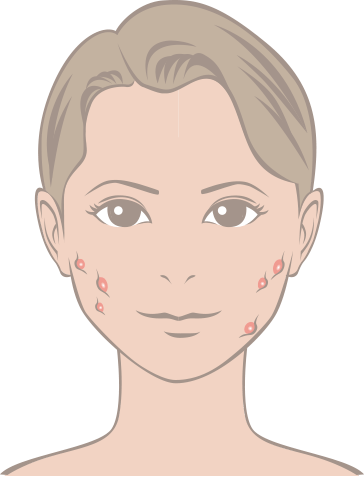Why do we get acne?
Other hormonal imbalances due to stress, lack of sleep, and poor diet leading to high levels of male hormones, can also cause acne.
The development of acne occurs in the following manner:
To reduce the growth of acne bacteria, it is important to wash your face properly. Proper cleansing is to remove sebum and dirt and keep the keratin functioning well, so it is important not to over-wash or under-wash your face. To avoid straining your skin, try to wash gently rather than scrubbing.
Various procedures for acne treatment
Oral and external medications
External medicine
- Antibiotics – act on the bacteria in the skin and reduce the occurrence of acne.
- Tretinoin – helps heal acne by decreasing the function of the sebaceous glands and making it easier to peel off the dead skin cells that clog the pores.
Immediately after the start of external treatment, there will be a certain amount of skin dryness and tingling sensation, but this will gradually lessen.
Oral medicine
- Antibiotics – effective when symptoms are severe and when ointments are not very effective.
- Vitamins B2 and B6 – known to reduce the activity of sebaceous glands.
- Vitamin C- can help improve post-acne inflammatory hyperpigmentation more quickly.
Chemical Peeling
Carbon peeling
This treatment removes dead skin cells and clogged pores, making acne less likely to occur and improving acne scars./p>
Carbon peeling is a highly effective treatment for open pores that are difficult to hide with makeup, black nose pores clogged with keratin plugs, and uneven acne scars, and it improves the texture of the skin.
The heat stimulates the production of collagen, which not only tightens the pores but also increases the tension and elasticity of the skin and improves the skin texture.
After the treatment, there is almost no redness or swelling, and you can wash your face and apply makeup right after the treatment, so you can take this treatment as part of your daily life.
eCO2 Laser
Affirm Multiplex
FNS (Derma Roller)
Compared to traditional dermaroller treatment, each needle is extremely fine, so the scars from the needles are almost invisible.
There is almost no bleeding or scabbing of the needle puncture marks.
This is a new technique recommended for those who are hesitant to undergo treatment with heat-generating fractional lasers.
Photo RF
Iontophoresis
Other acne treatments
In addition to chemical peels, carbon peels, eCO2, Affirm Multiplex, FNS, Photo RF, and iontophoresis, there are several other effective treatments for acne.
Thermacool was originally approved for the treatment of acne and is effective in tightening pores, suppressing the action of sebaceous glands, and improving the unevenness of acne scars by tightening and increasing collagen through heat.
Placenta injections, vitamin C injections, anti-aging drip infusion (special placenta drip), highly concentrated vitamin C drip, and other injections and drip therapies are used to balance the body from the inside and make it less prone to forming. These treatments also help relieve fatigue, whiten and beautify the skin, and are more effective when continued on a regular basis.
Combination of chemical peeling, carbon peeling, eCO2, Affirm Multiplex, FNS, photo RF, iontophoresis, thermacool, injection, and intravenous therapy can also be used to further improve acne treatment.
We provide the best treatment for acne and acne scars with customized treatments for each individual patient.
















